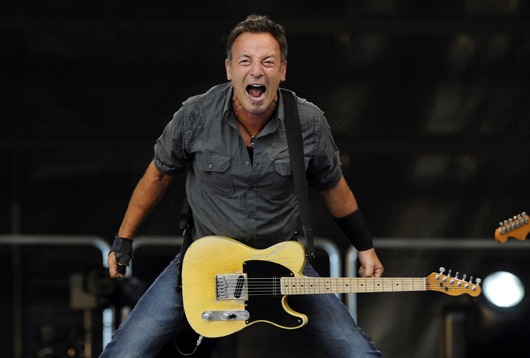Bruce Springsteen’s ‘Born to Run’: Fifty years on, it’s still the benchmark
Just under a year ago, Apple Music released their rather miscalculated 100 Best Albums list, and among the many classic albums insulted was Bruce Springsteen’s third, seminal album, Born to Run (1975). In this list, Springsteen ranked 22nd, behind entries from The Beatles and Micheal Jackson (fair enough), but also behind those from Taylor Swift and Kendrick Lamar.
For want of remaining as neutral as possible, I shall stick to voicing that perhaps Born to Run should have been a little bit higher. Succeeding his critically acclaimed yet poorly selling Greetings from Asbury Park, N.J. and The Wild, the Innocent & the E Street Shuffle (both 1973), Born to Run stands today as one of the highest-selling albums of all time.
Album sales aside, I deem Born to Run the most complete record of all time. Every track, and there are only eight of them, is perfect. In fact, Born to Run is one of only a few albums that can lay claim to that – another of those being his friend and contemporary Bob Seger’s Live Bullet (1976).
The album cover itself is also one of the most recognisable throughout the music world
Each track is defined by differing moods, tempos, and lengths, flowing into and complimenting each other, and each deserves its mention in this piece. From Roy Bittan’s opening piano chords and Springsteen’s harmonica in ‘Thunder Road’ to the late Clarence Clemons’ haunting saxophone solo in ‘Jungleland’, Born to Run was curated to be listened to chronologically, telling a universal story of attempted escapism into a more fulfilling life.
The album cover itself is also one of the most recognisable throughout the music world, Springsteen grasping the neck of his Fender Telecaster and leaning on his beloved (albeit mostly cropped out) saxophonist.
Side one of the record begins with ‘Thunder Road’, frequently cited as one of the greatest tracks ever recorded. Bittan’s piano and Springsteen’s harmonica and soft vocals get the album off to a mellow start, while Max Weinberg’s subtle drums and Bittan’s glockenspiel give the song some energy a quarter of the way through. Weinberg’s drum fill just before the four-minute mark gives way to the first of many iconic Clemons saxophone solos, eventually fading into the next track.
The second of two singles released from the album (January 1976), ‘Tenth Avenue Freeze-Out’ tells the story of the formation of the E Street Band. This track is driven by bluesy piano playing from Bittan and marks guitarist Steven Van Zandt’s maiden contribution to the band.
‘Night’, yet another track defined by Clemons’ saxophone towards its conclusion, gives way to ‘Backstreets’. Beginning relatively mellow in a similar fashion to ‘Thunder Road’, ‘Backstreets’ is uplifted at its midpoint by Brittan’s organ and Springsteen’s guitar. Springsteen’s repetition of the lyric “hiding on the backstreets” marks an emphatic conclusion to side one of the record, while this track also includes Springsteen’s first recorded use of the lyric “dancing in the dark”.
Side two begins with the titular track ‘Born to Run’, a song I think comes as close to musical perfection as humanly possible: lyrics that describe the will of a muscle car enthusiast and his love interest, Wendy, to escape the jammed highways and monotony of everyday life to an ideal existence; Danny Federici’s glockenspiel; Ernest Carter’s thumping drums that mimic the imperfect charisma of an eight-cylinder engine; and Clemons’ emphatic saxophone solo. And, just when you think the track has slowed for good, Springsteen’s “one, two, three, four” rejuvenates its energy until its climax.
As Born to Run celebrates its fiftieth anniversary, it is as good a time as any to look back on what was the breakthrough moment for Springsteen and his band as well as one definitive moment in music history
‘Born to Run’ has been among my favourite songs for as long as I’ve been listening to music, my taste in which derived from my dad’s CDs accompanying summertime car journeys to Norfolk’s own Monte Carlo, Great Yarmouth. And, while he was more into his harder rock – Queen, Guns N’ Roses, Bon Jovi – I like to think he surely must’ve rocked out to Springsteen at some point in his youth.
‘She’s the One’ is characterised by some more uptempo piano playing from Bittan and another killer Clemons saxophone solo, yet its tempo entirely dissipates into the next track, ‘Meeting Across the River’. The haunting, jazz-infused trumpets from Randy Brecker act as a bridge between the upbeat tempo of ‘She’s the One’ and the climactic ‘Jungleland’.
The track also acts as a geographical bridge in Springsteen’s story, “the tunnel” across the Hudson River advancing the narrative from the album’s previous New Jersey setting into Manhattan for the final track.
‘Jungleland’ is by some distance the longest track on the album, clocking in at nine minutes and thirty-five seconds. Suki Lahav’s violin and Bittan’s piano, to me resembling the intro to Elton John’s ‘Tiny Dancer’ released four years earlier, explode into life ninety seconds in with Bittan’s organ, Weinberg’s drums, and Springsteen’s rhythm guitar. Springsteen’s brief but exceptional guitar solo at the three-minute mark shortly gives way to what Springsteen dubbed in his autobiography (2016) Clemons’ “greatest recorded moment” – a hauntingly beautiful, two-minute saxophone solo, one last gift in the album.
Springsteen’s final remarks and Brittan’s piano then fade into silence to mark the end of a musical journey.
As Born to Run celebrates its fiftieth anniversary, it is as good a time as any to look back on what was the breakthrough moment for Springsteen and his band as well as one definitive moment in music history. Even though the album is still lauded by critics today, some more than others, as with Apple Music, it deserves each and every praise it gets.

Comments (2)
I agree, it’s a fantastic album and may not be his best.
The River and Nebraska are both great as well.